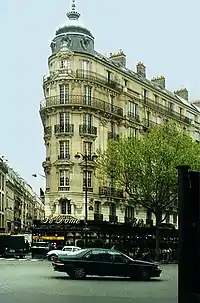Café society
Café society was the description of the "Beautiful People" and "Bright Young Things" who gathered in fashionable cafés and restaurants in New York, Paris and London beginning in the late 19th century. Maury Henry Biddle Paul is credited with coining the phrase "café society" in 1915.

Members attended each other's private dinners and balls, and took holidays in exotic locations or at elegant resorts. In the United States, café society came to the fore with the end of Prohibition in December 1933 and the rise of photojournalism to describe the set of people who tended to do their entertaining semi-publicly—in restaurants and night clubs—and who would include among them movie stars and sports celebrities. Some of the American night clubs and New York City restaurants frequented by the denizens of café society included the 21 Club, El Morocco, Restaurant Larue, and the Stork Club.[1]
See also
Bibliography
- Beebe, Lucius (1967). Clegg, Charles; Emrich, Duncan (eds.). The Lucius Beebe Reader. Garden City, N.Y.: Doubleday & Company. OCLC 720851.
- Blumenthal, Ralph (2000). Stork Club: America's Most Famous Nightspot and the Lost World of Café Society. Boston: Little, Brown & Co. ISBN 0-316-10531-7. OCLC 42072089.
References
-
"Book Reviews". Bronxville Record-Press. 1941-09-04. p. 15. Retrieved 2020-11-26.
In this collection of spicy sketches of the luminaries of metropolitan night life the author, an English newspaper correspondent and now resident in the United States, continues his reports of the process of his Americanization in the purlieus of the Stork and other New York night clubs.
Further reading
- Young, Anthony (28 May 2015). New York Café Society: The Elite Meet to See and Be Seen, 1920s–1940s. McFarland. ISBN 978-1-4766-1906-4. OCLC 931884327.
